Venus Express: mission overview
Why Venus?
Venus was the first planet to be explored by a spacecraft sent from Earth. Over a period of more than 20 years, from the early 1960s to the mid-1980s, the Soviet Union and the United States sent more than 30 automated craft towards the enigmatic world.
The numerous flyby craft, orbiters and short-lived landers revealed a planet that was similar in size and density to Earth, yet which had evolved in a very different way. Instead of our water-rich, temperate world, Venus had turned into a hellish, uninhabitable planet.
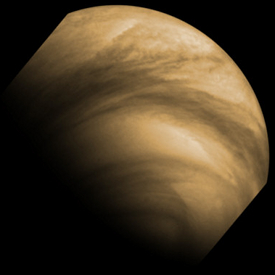 |
| Clouds on Venus. Credit: ESA/MPS/DLR/IDA |
Its unbroken blanket of yellowish clouds and dense, carbon dioxide rich atmosphere had resulted in a runaway greenhouse effect. The trapped heat caused the surface temperature to soar to 460 degrees Celsius, hot enough to melt lead. The crushing atmospheric pressure at the surface was 90 times greater than on Earth – comparable to the pressure at a depth of more than 900 metres beneath the ocean waves on Earth. It was little surprise that none of the Soviet or US landing craft survived for more than a couple of hours after touchdown.
Up above, the spacecraft revealed strange patterns in the clouds of sulphuric acid. Even more intriguing was the super-rotation of the atmosphere, with winds much stronger than any found on Earth sweeping the clouds right around the planet in only four days.
Although the entire surface was mapped in the early 1990s by a radar instrument on NASA's Magellan orbiter, revealing several upland "continents", recent volcanic plains and numerous volcanoes, Venus was largely a forgotten planet for more than a decade as the priority for investigations of the terrestrial planets shifted toward Mars.
There were, however, still a large number of fundamental questions to be answered about the past, present and future of Earth's sister planet. It was clear that an improved knowledge of Venus is essential if the general evolution of the terrestrial planets in the Solar System is to be understood. It was with this in mind that ESA and the European scientific community decided to proceed with Venus Express as a follow-on to the Mars Express mission.
A direct comparison of data from Mars Express and Venus Express was made easier by the fact that several of their instruments are identical or similar, while several of the Venus Express scientists were involved in both missions.
The Express Mission
Since Venus Express had a similar design and payload to its predecessor Mars Express, the industrial team led by EADS Astrium (now Airbus Defence & Space) was able to develop it at relatively low cost and in a remarkably short period of time for such a complex mission. The spacecraft was eventually built in only 33 months, compared with 48 months for Mars Express.
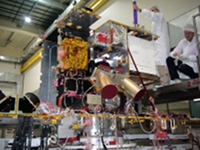 |
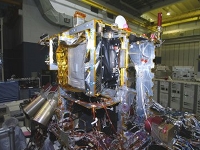 |
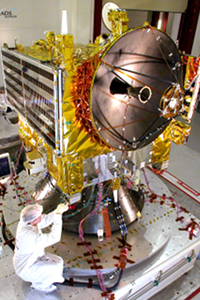 |
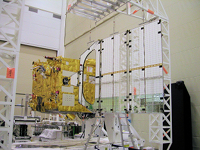 |
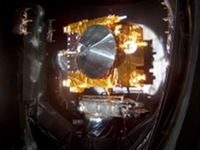 |
|
| The Venus Express spacecraft during testing. Credit: ESA/EADS Astrium | ||
Although Venus Express has many similarities to its predecessor, some significant changes had to be made because of the high temperatures that would be experienced in the vicinity of Venus. The thermal control system required larger, more efficient radiators and 23 layers of highly reflective gold insulation, instead of black. The abundance of incoming sunlight at Venus led to the redesign of its two solar arrays: they were about half the size of the panels on Mars Express and were fitted with triple junction gallium arsenide cells suitable for a high temperature environment.
The scientific payload on Venus Express comprised six instruments: three of these were re-used from Mars Express, one was an improved version of an instrument from Mars Express, and two were slightly modified instruments that were originally designed for ESA's Rosetta comet chaser. Another scientific experiment involved analysis of the spacecraft's radio transmissions back to Earth in order to investigate the atmosphere of Venus.
A mission of discovery
Venus Express was launched from Baikonur cosmodrome in Kazakhstan on 9 November 2005. It arrived at Venus on 11 April 2006 and braked into a highly elliptical (250 × 66 000 km), near-polar orbit which was specifically chosen to ensure the maximum scientific return. The orbit was 'locked' in space, with respect to the background stars, while the planet rotated beneath it. As a result, the spacecraft's instruments were able to observe almost the entire planet over a full Venusian day (243 Earth days).
The unusual orbit also meant that the spacecraft flew very low over the planet's northern hemisphere, enabling it to conduct high resolution observations of the clouds and surface. Near apocentre, its furthest point from the planet, Venus Express was able to achieve wide area coverage of the atmospheric conditions in the southern hemisphere, including the tracking of large cloud features.
Many of the spacecraft's observations have focused on the structure, dynamics, composition and chemistry of the dense atmosphere and the overlying clouds. One of the most fascinating features is the swirling vortex at the planet’s South Pole, which was found to be much more complex than previously thought. Venus Express showed that the internal structure of the vortex is highly variable, whilst its centre of rotation is located approximately three degrees of latitude away from the South Pole. The feature changes shape at least every 24 hours and drifts around the Pole over a period of five to 10 Earth days.
Other surprises included the discovery of a surprisingly cold region high in the planet’s atmosphere that may be frigid enough for carbon dioxide to freeze out as ice or snow, the discovery of a high altitude ozone layer and a mysterious layer of sulphur dioxide far above the main cloud layer.
Confirmation that Venus was probably much more humid and Earth-like early in its history was provided by data which indicated that water is still being lost from the upper atmosphere.
Some observations of the surface terrain were possible with the Visible and Infrared Thermal Imaging Spectrometer (VIRTIS). The data provide the best evidence to date that Venus has been volcanically active in recent geological times. In the upper atmosphere, enormous variations of sulphur dioxide have been discovered; on Earth, the only natural source of this gas is volcanic activity, so this variability provides tantalising hints that Venus' volcanoes are currently erupting.
It has long been known that Venus has no intrinsic magnetic field, although it does have a magnetosphere which results from the interaction between the planet's ionosphere and the solar wind. However, Venus Express revealed for the first time that magnetic reconnection – the process responsible for the Northern Lights on Earth – occurs in the nightside magnetosphere of Venus.
Venus Express went diving into the planet's upper atmosphere to altitudes only 165 km above the surface during a series of low passes 2008-2013, in order to measure the density of the upper polar atmosphere, an experiment that had never been attempted before at Venus. The campaign showed that the atmosphere high above the poles was a surprising 60% thinner than predicted.
| Venus Express will carry out an aerobraking experiment in summer 2014. (Further details and other formats available here.) Credit: ESA - C. Carreau |
After the conclusion of its main scientific mission in May 2014, the spacecraft’s altitude at closest approach to Venus was lowered even further, from 190 km to 130 km and eventually reaching a minimum of 129.2 km on 11 July. At this altitude the atmospheric drag on the spacecraft significantly altered its orbit, reducing it from 24 hours to 22 hours 20 minutes.
This was the first time that ESA conducted an aerobraking campaign, but it is hoped that the experience will benefit future missions. Following on from the success of the aerobraking phase, ESA is attempting to raise its altitude again and, if enough propellant is left in the tanks, it may carry out further observations of Venus.
With the new data from Venus Express, scientists are moving closer toward understanding this enigmatic world, although a number of mysteries remain. Why do the winds in the upper atmosphere blow so rapidly? What is the chemical in the clouds which absorbs UV light and creates the distinctive cloud patterns? What are atmospheric conditions like in the lower atmosphere, well below the main cloud deck? Does Venus today still have active volcanoes and earthquakes? At some point in its past did Venus ever have liquid water on its surface?
These are problems for future missions to explore. Japan has launched its Akatsuki spacecraft, which it is hoped will enter orbit around the planet in 2015, while Russia is planning to send the Venera-D orbiter and lander, its first Venus mission for 30 years, and European scientists have put forward proposals for a new mission to Venus.
Meanwhile, you can read more about some of the major discoveries made by Venus Express during the last eight years on the following pages:
| Major discoveries by Venus Express: 2006-2014 |
|
#5. Snow on Venus? |
|
#6. Ozone layer |
|
#7. Water loss |
